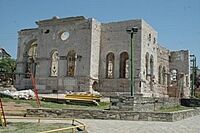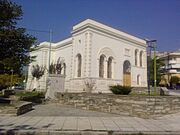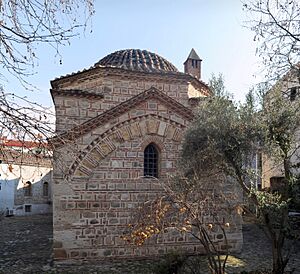Evrenos facts for kids
Quick facts for kids
Gazi Haci
Evrenos
|
|
|---|---|
| Nickname(s) | Gazi Baba |
| Died | 17 November 1417 Yenice-i Vardar, Ottoman Empire (now Giannitsa, Greece) |
| Buried |
Mausoleum of Ghazi Evrenos, Giannitsa
|
| Allegiance | Ottoman Empire |
| Battles/wars | Battle of Kosovo (1389) Battle of Nicopolis (1396) Battle of Maritsa Evrenos conquered Keşan, İpsala, Komotini, Feres, Xanthi, Maroneia, Serres, Monastir, and, in 1397, Corinth |
| Children | Ali Bey Evrenosoğlu |
Evrenos (died November 17, 1417) was a very important Ottoman military leader. He was also known as Evrenuz. He played a big role in the early days of the Ottoman Empire, helping it expand its lands. He served under several Ottoman rulers, including Murad I and Bayezid I.
Evrenos was a skilled general. He helped the Ottomans win many battles and conquer new territories. Some stories say he lived for a very long time. However, historians believe these stories might mix his achievements with those of his family members.
Contents
Evrenos's Life and Military Career
Evrenos was originally a noble from a small state called Karasi. He joined the Ottomans after they took over Karasi in 1345. There are different ideas about where his family came from. Some historians think he might have been of Greek origin. Others believe his family was Turkish. What is clear is that he became a key figure in the Ottoman army.
Evrenos led many important Ottoman campaigns. These included battles in areas like Bulgaria, Thessaly, and Serbia. After the Ottomans captured Adrianopolis in 1362, Evrenos was made a uc beği, which means a frontier warlord. This was a leader in charge of protecting and expanding the empire's borders.
He helped conquer many cities and regions. For example, he took over Komotini in 1363. He even built a special place for travelers there. Later, he also led the capture of Serres.
Major Battles and Conquests
Evrenos took part in some of the most famous Ottoman victories.
- The Battle of Maritsa was a huge win. A small Ottoman force surprised and defeated a much larger army of over 50,000 Serbian soldiers. This battle was a major step for Ottoman expansion.
- He also fought in the Battle of Kosovo in 1389. This was another crucial battle that helped the Ottomans gain control in the Balkans.
- In 1396, Evrenos was part of the Battle of Nicopolis. This battle was against a large European crusader army. The Ottomans won, showing their strength.
Evrenos conquered many places during his career. These included cities like Keşan, İpsala, Feres, Xanthi, Maroneia, Monastir, and Corinth in 1397. He also founded a town called Yenice-i Vardar, which is known today as Giannitsa in Greece.
Evrenos died in Yenice-i Vardar in 1417. He was buried in a special tomb there.
Evrenos's Legacy
As a very successful Ottoman commander, Evrenos became quite wealthy. He used his wealth to create many awqaf, which are special funds or properties set aside for charity or religious purposes. These endowments helped build and support public services.
Many buildings linked to him still exist in southeastern Europe. His türbe (mausoleum or tomb) in Giannitsa is very important. There is also a hammam (public bath) near his mausoleum. Other monuments can be found in Greek Thrace.
Evrenos's Family and Descendants
Evrenos had seven sons: Khidr-shah, Isa, Suleyman, Ali, Yakub, Barak, and Begdje. He also had several daughters.
His descendants, known as the Evrenosoğulları, became a very important family in the early Ottoman Empire. They were part of the Ottoman warrior nobility, along with other powerful families like the Mihaloğulları and the Turahanoğulları. These families helped shape the early Ottoman state.
See also
- Lala Shahin Pasha
- Çandarlı Kara Halil Hayreddin Pasha
- Umur the Lion
Images for kids





